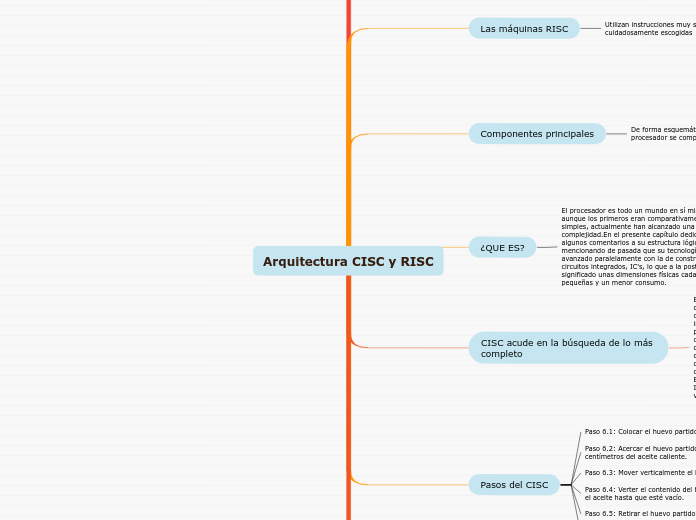Arquitectura CISC y RISC
To name your story, you have to think about the overall message and what you want your audience to understand from the story. Also, make it relevant and easy to remember.
The ending of a story is essential. We all know that if the ending is weak, what happened before loses its importance. So make it unpredictable, but fair. A resolved ending answers all the questions and ties up any loose threads from the plot.
ofrece un conjunto de instrucciones bastante completas y lentas de ejecutar, pero que agrupaban varias operaciones de bajo nivel en la misma instrucción. Esto da lugar a programas pequeños y sencillos de desarrollar que además realizaban pocos accesos a memoria
This is the closure section of the story.
See examples of possible outcomes below:
- all problems have been solved
- it's clear how each one of your characters ends up
- your main character is transformed by the challenge
Pasos del CISC
Paso 6.6: Tirar a la basura el huevo partido y ya vacío.
Paso 6.5: Retirar el huevo partido y ya vacío.
Paso 6.4: Verter el contenido del huevo partido sobre el aceite hasta que esté vacío.
Paso 6.3: Mover verticalmente el huevo partido.
Paso 6.2: Acercar el huevo partido a un par de centímetros del aceite caliente.
Paso 6.1: Colocar el huevo partido sobre la sartén.
CISC acude en la búsqueda de lo más completo
The middle of the story is where you add layers of complications that will lead to the end. Reveal more about the character's journey. Did their personality go through changes? How did they overcome the challenges? And as you build up the story’s central conflict, make it more personal to that character. Also, from the middle act, you have to lead into the final act.
En los años 50, todos los computadores se diseñaban de forma completamente aislada unos de otros. Esto hacía que sus instrucciones fuesen independientes, haciendo que un programa escrito para un cierto ordenador no se pudiese ejecutar en otro. A finales de la década, IBM reunió a un grupo de sus investigadores para estudiar la forma con la que un programa pudiese trabajar en múltiples computadores sin importantes cambios, ampliando la compatibilidad del software en diferentes máquinas. El resultado fue el enfoque CISC, Complex Instruction Set Computing, introducido por primera vez en los IBM System/360 el 7 de abril de 1964.
¿QUE ES?
El procesador es todo un mundo en sí mismo; aunque los primeros eran comparativamente simples, actualmente han alcanzado una notable complejidad.En el presente capítulo dedicaremos algunos comentarios a su estructura lógica, mencionando de pasada que su tecnología física ha avanzado paralelamente con la de construcción de circuitos integrados, IC's, lo que a la postre ha significado unas dimensiones físicas cada vez más pequeñas y un menor consumo.
Componentes principales
De forma esquemática podemos suponer que un procesador se compone de cinco elementos:
Conexiones con el exterior
Bus interno
Unidad de Control CU ("Control Unit"
Unidad Artimético-Lógica ALU ("Arithmetic and Logic Unit"
Memoria
Las máquinas RISC
Utilizan instrucciones muy simples, que deben ser cuidadosamente escogidas
Para cualquier operación se requieren varias instrucciones elementales.
Las instrucciones son muy simples, por tanto de ejecución rápida. La circuitería es más simple que en los procesadores CISC.
El lenguaje contiene un conjunto pequeño de instrucciones.
Tipos de arquitectura
In the beginning of the story (or the exposition), you will need to introduce the setting and characters. You might also want to introduce the main conflict. This part of the story is important because it gives the reader necessary background information and maybe even a first insight into a character’s personality.
DE DECISION
Characters are essential to a good story. Usually, the protagonist(s) is/are the most affected by the plot. Introduce a character by focusing on their actions, interests, and occupation, as the physical appearance doesn't make a difference in most cases.
Una de las primeras decisiones a la hora de diseñar un procesador es decidir cual será su juego de instrucciones. Este conjunto de instrucciones (órdenes) es el lenguaje que realmente entiende el procesador, y constituye lo que se conoce como lenguaje ensamblador o lenguaje-máquina
TIPOS DE ARQUITECTURA
Type in the name of your character.
RISC
Which traits best describe the character's personality? Choose more if necessary:
introvertedloyalkindindependentquick-thinkingadventuresomeidealisticsweet-naturedcalmrisk-takercreativewittystrictfussyweirdclumsyharshaggressivecarelessclingingcowardlycrueldeceitfulimpulsiveOther
Reduced Instruction Set Computer
CISC
Choose the type of your chacter:
Protagonist (main character)Antagonist (main character's opponent)Flat (stereotypical character)Round (his/ her personality develops throughout the story)Static (doesn't evolve as a person throughout the story)Dynamic (dramatical change in personality)Confidant (the main character trusts him/ her)Foil (contrasting character who enhances the personality of another character)Other
Complex Instruction Set Computer










